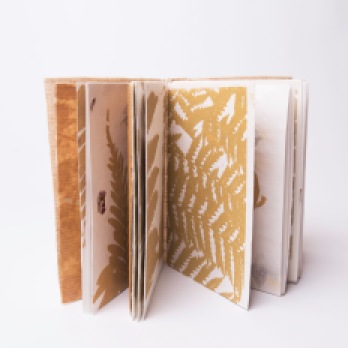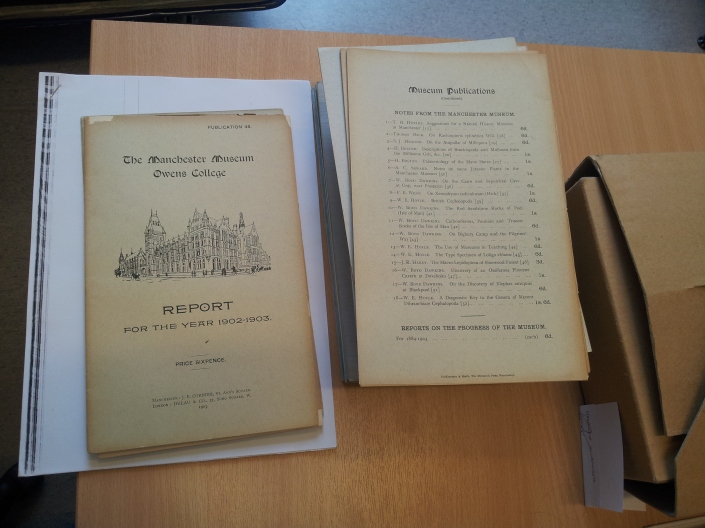Female Botanists
contemporary photography – ferns 2
Hi I’m Megan Jones current student, I previously posted about a project where I was granted access to photograph a section of the extensive herbarium collection at the museum. https://herbologymanchester.wordpress.com/2016/03/29/contemporary-photography-ferns/ As promised I have an update on the project now it has come to an end, after visiting the museum I took my images and wanted to experiment more with them.
I decided to experiment with screen printing for those who aren’t aware of this process, your image is transferred onto a ‘screen’ you then place a piece of paper underneath the screen placing ink at the top of the screen you spread the ink across the screen and this causes the ink to be pushed through creating a copy of your image on to the paper. I repeated this with all of the most successful images from my visit at the museum until I had a great collection, I then bound these into a handmade book using a long stitch wrap around style. Included in this book was my images once they had been processed with the screen printing technique and also some information on global warming as this was the theme at the museum during my visits, I felt it necessary to include some information in the finished project as this is where my inspiration seemed from at the start.
Thank you for taking the time to catch up on the development of my project.
Megan Jones
Voting, suffrage and dancing butterflies



These beautiful herbarium sheets were collected by Lydia Becker for the 1864 Botanical Competition and quite understandably she won a gold medal for them. Lydia Becker was enthusiastic about science but was frustrated by the limitations put on women at the time. Through this desire to be more involved with scientific life in the UK she became involved in wider campaigning for women’s sufferage – the right to vote. In 1860, only 60% of property-owning men over the age of 21 were allowed to vote. Lydia Becker became active in local suffrage societies and the edited a national journal; you can read an interesting account of her political life here. I particularly admire Lydia Becker as she was not only interested in women getting the vote, but had a much wider goal of equality between the sexes. One highlight of her life-time of campaigning came in 1867 when a shop-keeper called Lily Maxwell was entered onto the electoral role in Chorlton in error. Lydia Becker and a second lady escorted Lily Maxwell to the polling station where she was allowed to case her vote and became the first woman in the UK to do so. Her vote was later ruled illegal.
I hope Lydia Becker would have been pleased by the efforts of the artist Romuald Hazoumè to encourage everyone to make use of their hard-earned right to vote* and become a Butterfly activist……….
“To remind us all of the power of voters to topple or install politicians through the force of democracy, West African contemporary artist Romuald Hazoumè has asked the Museum to give away the butterflies from six pieces in his exhibition, Dance of the Butterflies on Election Day on May 7th. This is a fantastic and unique opportunity for visitors to own a piece of contemporary art from a leading West African artist.
We particularly want to encourage first time voters to participate, but anyone of voting age can be a butterfly activist. To participate voters simply come to the Museum on Thursday 7th May between 11am and 4pm, pledge to vote before the end of the day and crucially commit to encouraging one other person, through the gift of a butterfly, to do “something” to engage with politics – whether that be voting, joining a campaign, debating or some other political act.
All the Museum and artist ask is that they let us know what they will do and post about their gift on social media using the hashtag #DanceoftheButterflies.”
* Key dates in universal suffrage
1918 – All men over 21 in their county of residence gained the vote. Women over 30 who owned a property (or whose husband owned a property) gained the vote.
1929 – All women over 21 gained the vote.
1968 – Voting age lowered to 18 for both men and women.

Visiting Liverpool World Museum

This time last week we travelled over to Liverpool to catch up with colleagues who work in herbaria in the North West of the UK. It was lovely to have the opportunity to get together and discuss what we’re all doing (projects, aquisitions and the day to day) and it also meant that we got to have a good look round the Liverpool herbarium. With our storage looking like this:

………….Liverpool’s was a vision of order and function. Lindsey and I have got our eye on a few improvements to try out!



We also had a tour of the museum’s City Wildflower Meadow by Donna Young, Curator of Herbarium, . In prime postition right at the main entrance, the meadow is now in it’s second year and must have been a blaze of colour in midsummer. It had largely run to seed when we visited, but there were still a few flowers (such as yellow toadflax, the odd scabious flower and some dark mullein) making the most of the last days of summer. Donna explained that this year the yellow rattle (Rhinanthus minor) had really started to settle in and as it parasitises the more vigorous plants like grasses it will help to maintain the diversity of the meadow in future. We’ll have to come see it in all it’s glory next year!

Coralroot orchid and Walney Island geranium
Geranium sanguineum var. striatum (Walney Island geranium) found only on Walney island, to the west of Barrow-in-Furness, was spotted flowering this week on sand dunes by one of our botany volunteers. 
The coral root orchid (Corallorhiza trifida) is a parasite growing in association with a fungus. It grows on the creeping willow at Sandscale Haws. It was found after arranging a visit with the warden, as it is endangered. Last year no plants were seen at this location but this year over 70 plants were counted.
Trees of the British Isles
Hello! My name is Alyssa and I’m the placement student in the herbarium, I have been working here for this academic year as part of my degree. Ordinarily I am a Plant Science student at the University of Manchester, currently in my third year with my final year starting this September. As part of my degree, I get to spend my third year away from my studies at uni (not that far away in my case) in a work place applying knowledge and skills from the first two years of my degree. While at the herbarium I have produced an app for keying out common British trees.
Recently, I have noticed that a lot of people are disinterested in botany, and have no desire to learn about it. So I wanted to attempt to inspire people to learn more about the wonderful world of botany. And maybe, one day, become themselves a converted botany enthusiast! Hence my app… I realise that most of you will already be botanical enthusiasts, but the app might still teach you something new!
To make the app I used Bentham and Hooker’s Handbook of British Flora. George Bentham first published this key in 1858 with the aim to enable people with no prior botanical knowledge to “name the wild flowers they may gather on their country rambles”. It was Bentham’s most famous work, has been used by students for over a century, running into many editions. After Bentham’s death in 1884, it was edited by his younger colleague Joseph Dalton Hooker and became known as Bentham & Hooker. I have used the accompanying illustration book plus Flora von Deutschland, Österreich und der Schweiz, published 1885 by Prof. Otto Wilhelm Thomé, for the photos in the app. Most common and native British trees are covered in the app, so much fun can be had tree hunting with the help of this very handy app!
The app is available on the Google Play store under ‘Trees of the British Isles’. It is also available for Apple and Windows, but you need to visit the web address and save the page as a bookmark on your homescreen, once accessed online once it will work as an offline app.
If you could be helpful to me and fill in my questionnaire that would be fabulous! Thank you to you all! Remember, trees are fun.
The app can be accessed here, with a link to the questionnaire in it.
http://personalpages.manchester.ac.uk/staff/giles.johnson/alyssa/index.html
Fern Hunting in China
 There are 1500 species of fern in Yunnan Province, China – compared to just 50 in Britain. Yvonne Golding of the British Pteridiological Society arranged a fern hunting trip to Yunnan last year, and in February 2011 gave a talk with slides about the hundreds of ferns they saw, what they ate and the people they met.
There are 1500 species of fern in Yunnan Province, China – compared to just 50 in Britain. Yvonne Golding of the British Pteridiological Society arranged a fern hunting trip to Yunnan last year, and in February 2011 gave a talk with slides about the hundreds of ferns they saw, what they ate and the people they met.
Two herbarium sheets and some of Yvonne’s chinese fern books
International Women’s Day 2010
Today is International Women’s Day. To mark the occasion the museum organised a short lunchtime tour and talk celebrating the pioneering work of some women associated with the Manchester Museum.
We met in the reception area of the Museum where Anna Bunney, Curator of Public Programmes gave an introduction to the tour and talked about the history of women working in the Museum. We then went upstairs to to the Manchester Gallery where the work of some of our pioneering female botanists is showcased. Andrea Winn, Curator of Community Exhibitions, gave a great talk about why Lydia Becker, Kathleen Drew-Baker, Marie Stopes and Jessie Heywood were so important not just to the advancement of rights for women but also for their contribution to the advancement of science.
Finally we took the group up to the herbarium where I had laid out some more information and specimens collected by these women. Here the group had the opportunity to see some specimens at close range and even handle some of the more robust objects. The group seem fascinated and interested by the tour. However, I was especially pleased when one Phd student told me how much she was inspired and motivated by the stories of these women. I’m sure Jessie, Kathleen, Marie and Lydia would be delighted to know that their hard work is still having a positive effect on women of the 21st Century – thank you ladies!
Specimen of the Day: 15/12/2009 – New Zealand Christmas Tree
Keeping with the Christmas theme, todays specimens are seeds from Pōhutukawa (Metrosideros excelsa/Metrosideros tomentosa) aka. the New Zealand Christmas Tree.
Brilliant crimson flowers cover this tree between November and January, peaking in mid to late December (summertime in the southern hemisphere). In New Zealand the native Pōhutukawa is under threat by the introduced common bushtail possum which strips the tree of its leaves. The possum was introduced to New Zealand in the 1800s to establish a fur industry but it has now become a major pest.
These seeds are one of many specimens collected in New Zealand by Miss Jessie Heywood (1852-1947). Jessie regularly sent packages of specimens from New Zealand to the Manchester Museum. As Jessie is one of my favourite collectors I’ll devote separate post to her story later on.














